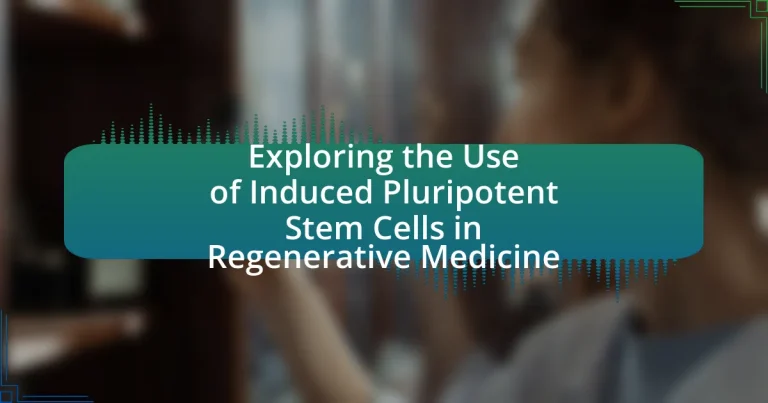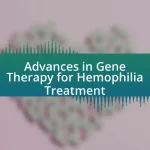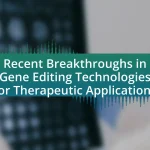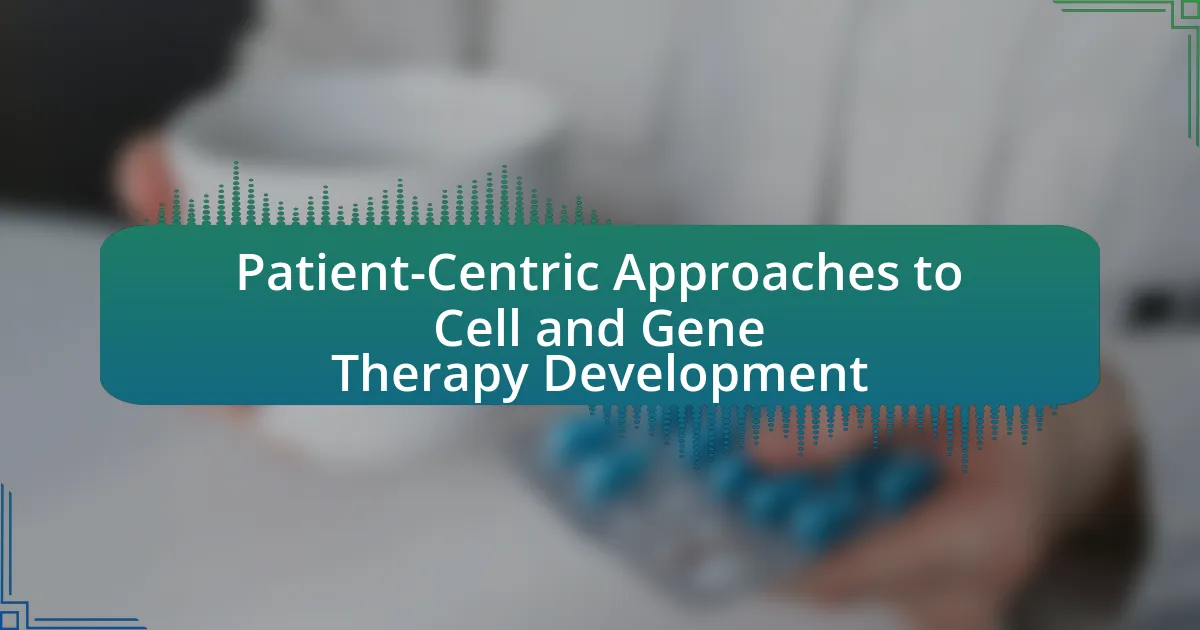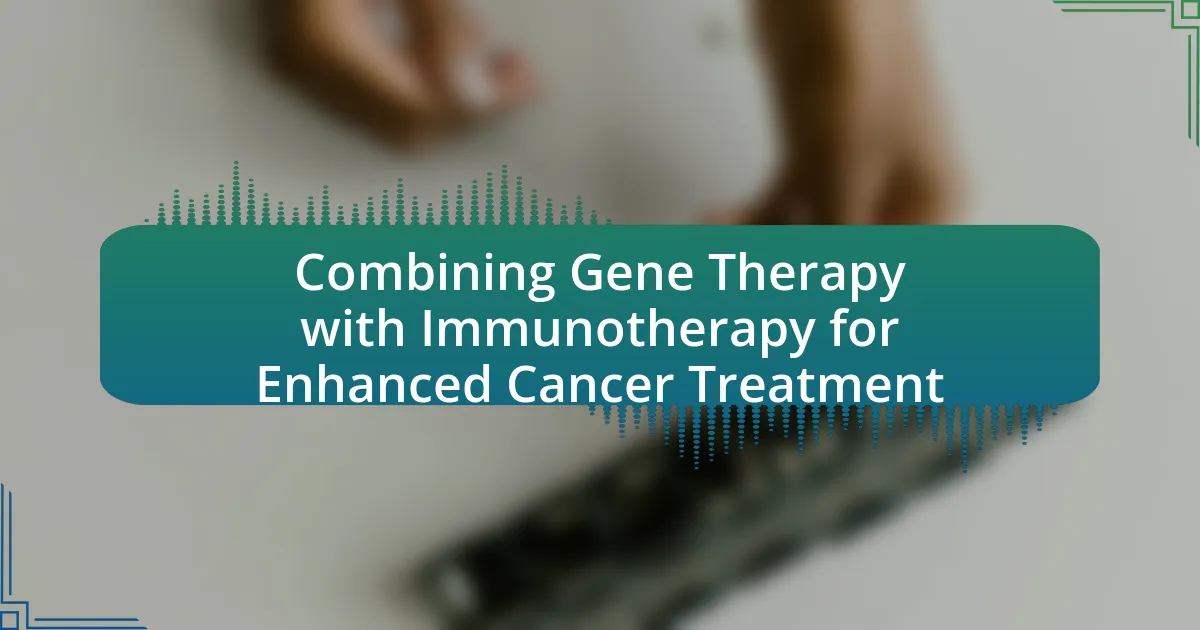Induced Pluripotent Stem Cells (iPSCs) are a revolutionary type of stem cell derived from adult somatic cells, capable of differentiating into any cell type in the body, making them essential for regenerative medicine. This article explores the generation of iPSCs through the introduction of specific transcription factors, the techniques used for their reprogramming, and the factors influencing their efficiency. It also examines the characteristics that define iPSCs, their comparison with embryonic stem cells, and their applications in treating various diseases, including neurodegenerative and cardiovascular conditions. Additionally, the article addresses the challenges and ethical considerations surrounding iPSC research, including tumorigenicity, genetic stability, and the importance of informed consent. Finally, it outlines best practices for researchers working with iPSCs to ensure safety and efficacy in therapeutic applications.
-1.webp)
What are Induced Pluripotent Stem Cells (iPSCs)?
Induced Pluripotent Stem Cells (iPSCs) are a type of stem cell that can be generated directly from adult cells through the introduction of specific genes. These cells possess the ability to differentiate into any cell type in the body, similar to embryonic stem cells, which makes them valuable for regenerative medicine. The process of creating iPSCs was first demonstrated by Shinya Yamanaka in 2006, who identified four transcription factors—Oct4, Sox2, Klf4, and c-Myc—that can reprogram somatic cells into a pluripotent state. This breakthrough has significant implications for disease modeling, drug discovery, and potential therapeutic applications, as iPSCs can be derived from a patient’s own cells, reducing the risk of immune rejection.
How are iPSCs generated?
Induced pluripotent stem cells (iPSCs) are generated by reprogramming somatic cells through the introduction of specific transcription factors. This process typically involves the use of four key factors: Oct4, Sox2, Klf4, and c-Myc, which are delivered into the somatic cells via viral vectors or other methods. The introduction of these factors induces a pluripotent state, allowing the cells to differentiate into various cell types. The validity of this method is supported by the landmark study by Takahashi and Yamanaka in 2006, which demonstrated that mouse fibroblasts could be reprogrammed into iPSCs using these factors, paving the way for further research and applications in regenerative medicine.
What techniques are used to reprogram somatic cells into iPSCs?
The primary techniques used to reprogram somatic cells into induced pluripotent stem cells (iPSCs) include the use of transcription factors, viral vectors, and small molecules. Transcription factors, such as Oct4, Sox2, Klf4, and c-Myc, are introduced into somatic cells to induce pluripotency. This method, known as the Yamanaka factors approach, was first demonstrated by Shinya Yamanaka in 2006, showing that these factors could convert fibroblasts into iPSCs. Viral vectors, particularly lentiviruses and retroviruses, are commonly employed to deliver these transcription factors into the target cells, facilitating their integration into the host genome. Additionally, small molecules can be used to enhance reprogramming efficiency by modulating signaling pathways and epigenetic modifications, further supporting the transition to a pluripotent state. These techniques have been validated through numerous studies, establishing their effectiveness in generating iPSCs for research and therapeutic applications.
What factors influence the efficiency of iPSC generation?
The efficiency of induced pluripotent stem cell (iPSC) generation is influenced by several key factors, including the choice of reprogramming factors, the method of delivery, the source of somatic cells, and the culture conditions. Research indicates that using specific combinations of transcription factors, such as Oct4, Sox2, Klf4, and c-Myc, can significantly enhance reprogramming efficiency. Additionally, the method of delivering these factors, whether through viral vectors or non-viral methods, impacts the success rate; for instance, non-integrating methods tend to yield safer and more efficient outcomes. The source of somatic cells, such as fibroblasts versus blood cells, also plays a crucial role, with certain cell types demonstrating higher reprogramming potential. Lastly, optimized culture conditions, including the use of specific media and growth factors, can further improve the yield of iPSCs. These factors collectively determine the overall efficiency of iPSC generation, as evidenced by various studies in the field.
What characteristics define iPSCs?
Induced pluripotent stem cells (iPSCs) are characterized by their ability to differentiate into any cell type in the body, a property known as pluripotency. This characteristic is achieved through the reprogramming of somatic cells, typically by introducing specific transcription factors such as Oct4, Sox2, Klf4, and c-Myc. iPSCs also exhibit self-renewal capabilities, allowing them to proliferate indefinitely while maintaining their pluripotent state. Additionally, iPSCs are derived from adult tissues, which makes them less ethically controversial compared to embryonic stem cells. These defining characteristics enable iPSCs to be a valuable tool in regenerative medicine, as they can potentially generate patient-specific cells for therapeutic applications.
How do iPSCs compare to embryonic stem cells?
Induced pluripotent stem cells (iPSCs) are similar to embryonic stem cells (ESCs) in their ability to differentiate into any cell type, but they differ significantly in their origin and ethical implications. iPSCs are generated by reprogramming somatic cells, which avoids the ethical concerns associated with the use of embryos, while ESCs are derived from the inner cell mass of blastocysts. Additionally, iPSCs can be created from adult tissues, making them more accessible for research and therapeutic applications. Studies have shown that iPSCs exhibit comparable pluripotency and differentiation potential to ESCs, as evidenced by their ability to form teratomas and contribute to tissue regeneration in animal models.
What are the key properties of iPSCs that make them valuable in research?
Induced pluripotent stem cells (iPSCs) possess key properties that make them invaluable in research, including their ability to differentiate into any cell type, self-renew indefinitely, and their derivation from adult somatic cells. The pluripotency of iPSCs allows researchers to generate specific cell types for studying disease mechanisms, drug testing, and potential therapeutic applications. Their self-renewal capability enables the production of large quantities of cells, which is essential for extensive research and clinical applications. Furthermore, since iPSCs can be generated from a patient’s own cells, they offer a unique advantage in personalized medicine, reducing the risk of immune rejection. These properties are supported by studies demonstrating successful differentiation of iPSCs into various cell types, such as neurons and cardiomyocytes, highlighting their versatility and potential in regenerative medicine.
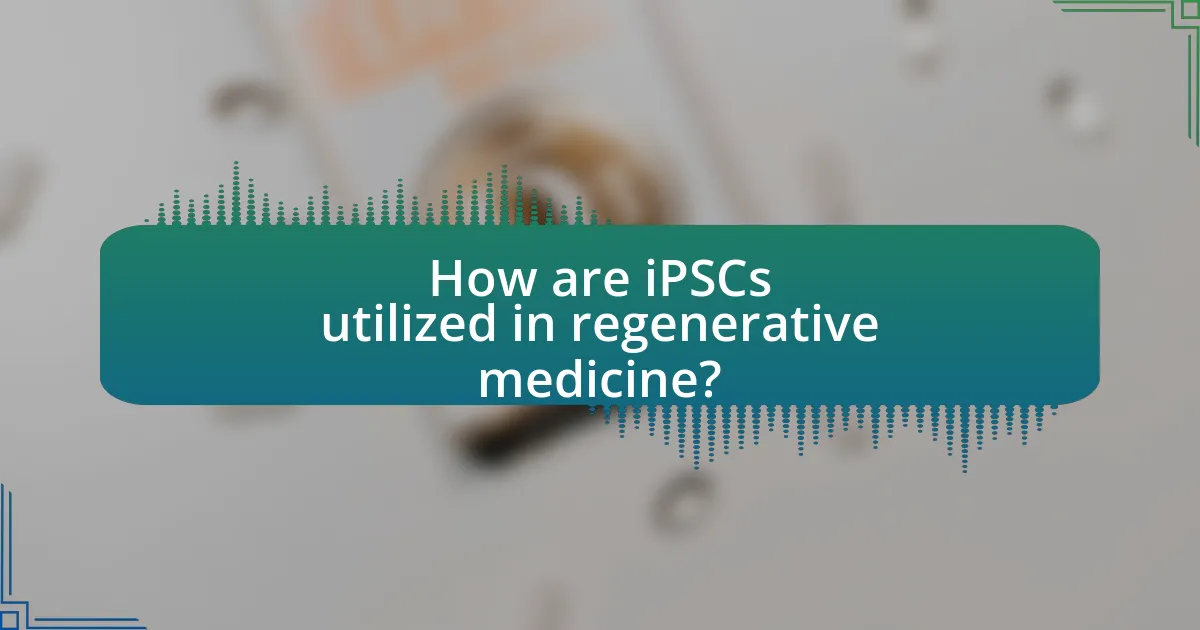
How are iPSCs utilized in regenerative medicine?
Induced pluripotent stem cells (iPSCs) are utilized in regenerative medicine primarily for their ability to differentiate into various cell types, enabling the repair or replacement of damaged tissues and organs. iPSCs are derived from adult somatic cells through reprogramming, allowing them to regain pluripotency, which is the capacity to develop into any cell type in the body. This characteristic is crucial for applications such as cell therapy, where iPSCs can be transformed into specific cell types, like neurons or cardiomyocytes, to treat conditions such as Parkinson’s disease or heart failure. Additionally, iPSCs facilitate drug testing and disease modeling, providing insights into disease mechanisms and potential therapeutic targets. Their use in regenerative medicine is supported by studies demonstrating successful integration and function of iPSC-derived cells in animal models, highlighting their potential for clinical applications.
What diseases can be treated using iPSCs?
Induced pluripotent stem cells (iPSCs) can be used to treat a variety of diseases, including neurodegenerative disorders, cardiovascular diseases, diabetes, and certain types of cancer. iPSCs have the ability to differentiate into any cell type, which allows for the potential regeneration of damaged tissues and organs. For instance, research has shown that iPSCs can be differentiated into neurons for the treatment of Parkinson’s disease and amyotrophic lateral sclerosis (ALS). Additionally, iPSCs have been utilized in developing therapies for heart disease by generating cardiomyocytes to repair damaged heart tissue. Studies have also indicated their application in diabetes management through the generation of insulin-producing pancreatic cells. The versatility of iPSCs in regenerative medicine highlights their potential in addressing a wide range of diseases.
How do iPSCs contribute to the treatment of neurodegenerative diseases?
Induced pluripotent stem cells (iPSCs) contribute to the treatment of neurodegenerative diseases by providing a renewable source of patient-specific neurons for research and potential therapies. iPSCs can be generated from a patient’s somatic cells, allowing for the modeling of diseases such as Alzheimer’s and Parkinson’s in vitro, which facilitates the understanding of disease mechanisms and the testing of new drugs. Studies have shown that iPSCs can differentiate into various neural cell types, enabling the replacement of damaged neurons and supporting the regeneration of neural tissue. For instance, research published in “Nature” by Takahashi and Yamanaka in 2006 demonstrated the successful reprogramming of fibroblasts into iPSCs, highlighting their potential in regenerative medicine.
What role do iPSCs play in cardiac repair and regeneration?
Induced pluripotent stem cells (iPSCs) play a crucial role in cardiac repair and regeneration by providing a renewable source of cardiomyocytes and other cardiac cell types for therapeutic applications. iPSCs can be generated from adult somatic cells, allowing for patient-specific therapies that minimize immune rejection. Research has demonstrated that iPSCs can differentiate into functional cardiomyocytes, which can be used to replace damaged heart tissue following myocardial infarction or other cardiac diseases. For instance, a study published in Nature in 2012 by Lian et al. showed that iPSCs could be efficiently differentiated into cardiomyocytes, which exhibited electrical and mechanical properties similar to native heart cells. This ability to generate heart cells from iPSCs not only aids in cell replacement strategies but also enhances our understanding of cardiac development and disease modeling, ultimately contributing to advancements in regenerative medicine.
What are the potential applications of iPSCs in tissue engineering?
Induced pluripotent stem cells (iPSCs) have significant potential applications in tissue engineering, primarily due to their ability to differentiate into various cell types and their capacity for self-renewal. iPSCs can be utilized to generate specific tissues, such as cardiac, neural, and hepatic tissues, which can be used for disease modeling, drug testing, and regenerative therapies. For instance, research has demonstrated that iPSCs can effectively produce cardiomyocytes, which are essential for heart tissue engineering, thereby offering a promising avenue for treating heart diseases (Zhang et al., 2013, Nature). Additionally, iPSCs can be combined with biomaterials to create scaffolds that support tissue regeneration, enhancing the integration and functionality of engineered tissues.
How can iPSCs be used to create organoids for research and therapy?
Induced pluripotent stem cells (iPSCs) can be used to create organoids by differentiating them into specific cell types that mimic the architecture and function of actual organs. This process involves culturing iPSCs in a three-dimensional environment with specific growth factors and extracellular matrix components, which guide their development into organ-like structures. Research has demonstrated that iPSCs-derived organoids can replicate key features of organs such as the brain, liver, and intestines, providing valuable models for studying disease mechanisms and drug responses. For instance, a study published in Nature in 2013 by Clevers et al. showcased how iPSC-derived intestinal organoids can be used to model gastrointestinal diseases, highlighting their potential in both research and therapeutic applications.
What advancements have been made in using iPSCs for transplantable tissues?
Recent advancements in using induced pluripotent stem cells (iPSCs) for transplantable tissues include the successful generation of functional cardiac, neural, and pancreatic tissues. For instance, researchers have developed methods to differentiate iPSCs into cardiomyocytes, which have shown promise in repairing heart damage, as demonstrated in a study published in Nature in 2020 by Zhang et al., where iPSC-derived cardiomyocytes were used in a preclinical model of myocardial infarction. Additionally, advancements in 3D bioprinting techniques have enabled the creation of complex tissue structures from iPSCs, enhancing the potential for organ transplantation. A study in Advanced Healthcare Materials in 2021 by Lee et al. highlighted the successful bioprinting of vascularized tissues using iPSCs, which is crucial for improving graft survival and function. These developments indicate significant progress in the application of iPSCs for regenerative medicine and transplantable tissues.

What challenges and ethical considerations surround the use of iPSCs?
The challenges and ethical considerations surrounding the use of induced pluripotent stem cells (iPSCs) include issues related to genetic manipulation, potential tumorigenicity, and informed consent. Genetic manipulation raises concerns about unintended consequences and long-term effects on the genome, as iPSCs can differentiate into various cell types, potentially leading to uncontrolled growth. Tumorigenicity is a significant risk, as some iPSC-derived cells may form tumors if not properly regulated. Ethical considerations also encompass the necessity for informed consent from donors, particularly regarding the use of their cells in research and therapy, ensuring that individuals understand the implications of their contributions. These challenges highlight the need for stringent regulatory frameworks and ethical guidelines to govern iPSC research and applications in regenerative medicine.
What are the technical challenges in using iPSCs for therapy?
The technical challenges in using induced pluripotent stem cells (iPSCs) for therapy include issues related to genetic stability, differentiation control, and immune rejection. Genetic stability is a concern because iPSCs can acquire mutations during reprogramming or culture, which may lead to tumorigenesis. Differentiation control poses a challenge as achieving the desired cell type with high purity and functionality is complex, often resulting in heterogeneous cell populations. Immune rejection is another significant hurdle, as even though iPSCs can be derived from a patient’s own cells, the reprogramming process may alter their immunogenic profile, potentially leading to adverse immune responses. These challenges necessitate ongoing research to develop safer and more effective therapeutic applications of iPSCs.
How do issues of tumorigenicity affect iPSC applications?
Issues of tumorigenicity significantly limit the applications of induced pluripotent stem cells (iPSCs) in regenerative medicine. Tumorigenicity refers to the potential of cells to form tumors, which poses a major safety concern when using iPSCs for therapeutic purposes. Research indicates that iPSCs can retain the ability to proliferate uncontrollably, leading to teratoma formation when transplanted into living organisms, as demonstrated in studies where teratomas developed in animal models following iPSC implantation. This risk necessitates rigorous screening and characterization of iPSC lines to ensure their safety before clinical application. Consequently, the presence of tumorigenic potential in iPSCs restricts their use in therapies aimed at treating degenerative diseases, as the benefits must be weighed against the risks of tumor development.
What are the challenges in ensuring the safety and efficacy of iPSC-derived therapies?
The challenges in ensuring the safety and efficacy of iPSC-derived therapies include genetic stability, potential tumorigenicity, and immune rejection. Genetic stability is a concern because iPSCs can acquire mutations during reprogramming or culture, which may lead to abnormal cell behavior. Studies have shown that some iPSC lines exhibit genomic alterations that could compromise their safety (e.g., a study published in Nature in 2012 by Laurent et al. highlighted the risk of chromosomal abnormalities in iPSCs). Tumorigenicity arises from the possibility that undifferentiated iPSCs or partially differentiated cells may form tumors upon transplantation. Research has indicated that specific differentiation protocols are necessary to minimize this risk (e.g., a 2016 study in Cell Stem Cell by Takahashi et al. emphasized the importance of thorough differentiation). Lastly, immune rejection can occur if the iPSC-derived cells are not autologous, leading to an immune response against the transplanted cells. This challenge necessitates careful consideration of the source of iPSCs and potential immunosuppressive strategies.
What ethical concerns are associated with iPSC research?
Ethical concerns associated with iPSC research include issues related to consent, potential for misuse, and the implications of genetic manipulation. Consent is critical, as obtaining informed consent from donors of somatic cells is necessary to ensure ethical standards are met. Additionally, the potential for misuse of iPSCs in creating genetically modified organisms raises concerns about bioengineering and the long-term effects on biodiversity and human health. Furthermore, the manipulation of genetic material can lead to unforeseen consequences, such as tumorigenesis, which poses risks to patients receiving therapies derived from iPSCs. These concerns highlight the need for stringent ethical guidelines and oversight in iPSC research to safeguard against potential abuses and ensure responsible scientific advancement.
How do consent and donor rights play a role in iPSC research?
Consent and donor rights are critical in iPSC research as they ensure ethical standards and respect for individuals contributing biological materials. Informed consent must be obtained from donors, detailing how their cells will be used, which aligns with ethical guidelines established by organizations such as the International Society for Stem Cell Research. This process protects donor autonomy and rights, allowing individuals to make informed decisions about their biological contributions. Furthermore, adherence to regulations, such as the U.S. Common Rule, mandates that donors are fully aware of the potential risks and benefits associated with their participation, reinforcing the ethical framework within which iPSC research operates.
What regulations govern the use of iPSCs in clinical settings?
The use of induced pluripotent stem cells (iPSCs) in clinical settings is primarily governed by regulations established by the U.S. Food and Drug Administration (FDA) and the European Medicines Agency (EMA). The FDA classifies iPSC-based therapies as biologics, requiring compliance with the Public Health Service Act and the Federal Food, Drug, and Cosmetic Act, which mandate rigorous preclinical and clinical testing for safety and efficacy. Similarly, the EMA oversees iPSC applications under the Advanced Therapy Medicinal Products (ATMP) regulation, which necessitates adherence to Good Manufacturing Practices (GMP) and comprehensive clinical trial protocols. These regulatory frameworks ensure that iPSC therapies meet stringent safety and ethical standards before they can be approved for clinical use.
What best practices should researchers follow when working with iPSCs?
Researchers working with induced pluripotent stem cells (iPSCs) should adhere to best practices that ensure the integrity and reproducibility of their experiments. First, maintaining a sterile environment is crucial to prevent contamination, as iPSCs are highly sensitive to microbial infections. Second, researchers should use validated protocols for reprogramming somatic cells into iPSCs, ensuring that the methods employed yield high-quality and pluripotent cells. Third, regular characterization of iPSCs through assays such as flow cytometry for surface markers and differentiation potential is essential to confirm their pluripotency and genetic stability. Additionally, researchers should implement rigorous quality control measures, including genetic screening for mutations and epigenetic profiling, to ensure the safety and efficacy of iPSCs for therapeutic applications. These practices are supported by studies indicating that adherence to stringent protocols significantly enhances the reliability of iPSC research outcomes.
